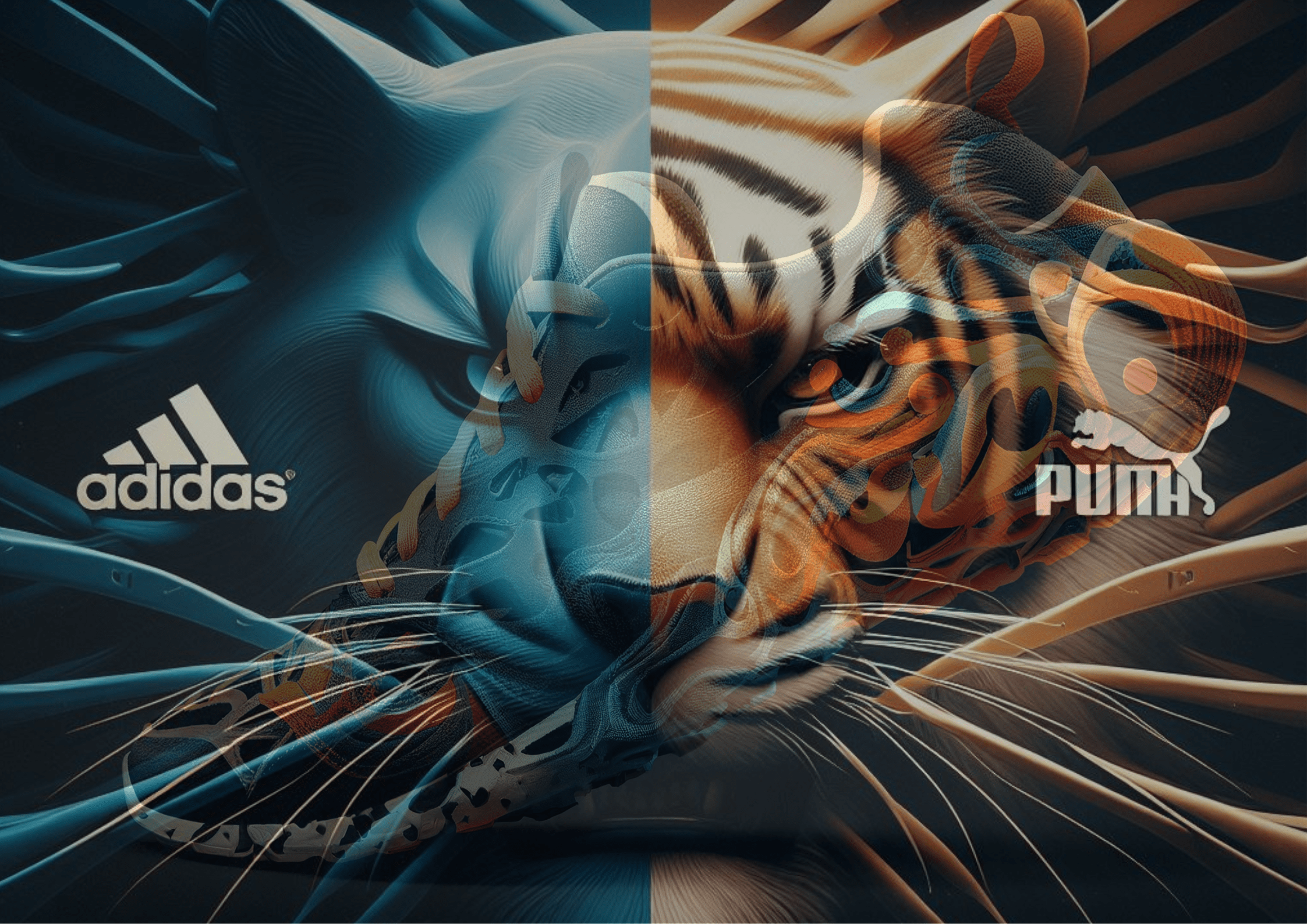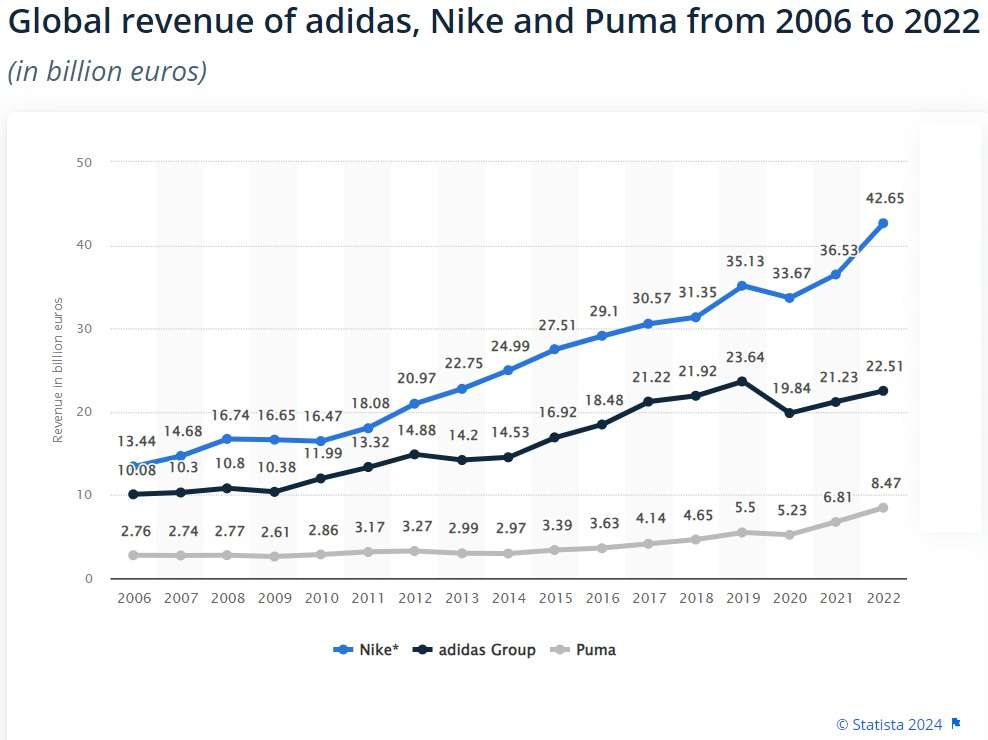- 2 January 2024
- No Comment
- 223
From Sibling Rivalry to Global Titans: Journey of Adidas and Puma

Get ready for an exciting journey into the world of sportswear with the captivating stories of Adidas and Puma.
When two brothers, Adi, and Rudi Dassler, kicked off a dream in a cozy Bavarian village during the 1920s, their shared vision turned their mom’s washing room into the birthplace of the Dassler Brothers Shoe Company.
As their business soared, so did the tensions, resulting in a split that birthed the athletic giants—Adidas and Puma.
Today, Adidas and Puma stand tall as the world’s second and third-largest sportswear manufacturers, respectively (with Nike leading the pack),
Puma, a sporting goods manufacturer, brings you an array of footwear, apparel, and accessories under brands like PUMA, Stichd, and Cobra Golf.
Whether you’re looking for soccer cleats for youth or stylish running shoes for women, Puma’s influence spans the globe, sponsoring national teams across various sports.
Adidas is a powerhouse in athletic and lifestyle products. From Adidas shoes to sportswear and Adidas originals, this brand is a global leader in the industry.
Whether you’re searching for the best running shoes for men or outdoor sports apparel, Adidas has you covered.
Hi, I’m Nabeel Shaikh, a number guy. Before we start discovering their rich histories and contributions to athletic fashion, let’s discuss some numbers from Adidas and Puma. It’s a tale of competition, innovation, and style—making it a must-read for anyone passionate about sportswear.
Despite their shared roots and still being headquartered in the same town, these corporate giants have evolved far beyond their family origins and are now publicly traded on the Frankfurt Stock Exchange.
In 2023, Puma reported $8.9 billion in revenue, while Adidas led with $23.7 billion.
As of January 2024, Adidas holds a market cap of $35.61 billion, ranking 526th globally, and Puma boasts a market cap of $8.27 billion.
As of November 2023, Adidas experienced stellar sales with men’s street footwear and women’s apparel emerging as the top-selling products for the year. Notably, Adidas footwear stands out as Adidas’ powerhouse, contributing to over 50% of their total net sales.
Puma experienced a remarkable 28.8% surge in Puma shoes and footwear sales in 2023, propelled by the success of its performance lines, including running, football, and basketball.
Puma’s new Terrace Sneakers, Palermo and Super Team, garnered strong demand, contributing to the brand’s flourishing sales.
Beyond consumer markets, Puma stands out as a major producer of enthusiast driving shoes and race suits, trusted by Formula 1 teams like Mercedes AMG Petronas, Scuderia Ferrari, and Alfa Romeo
Market Share
Let’s break down the market share showdown between Adidas and Puma in different parts of the world:
Europe, Middle East, and Africa (EMEA): Adidas takes a small lead with 38% compared to Puma’s 36.8%.
North America (including Latin America): Puma takes a big leap ahead with a substantial 43.5%, while Adidas holds 28%.
Greater China: Adidas claims 14%.
Asia Pacific: Puma leads the way with 19.7%, leaving Adidas at 10%.
Latin America: Adidas holds 9%.
In a nutshell, Puma shines in North America and Asia Pacific, while Adidas holds its ground in EMEA and Greater China. It’s a global competition, and each brand has its strongholds!

The Dassler Brothers’ Humble Beginnings
Step into the time machine and journey back to 1924 when the Dassler saga began. In the quaint Bavarian town of Herzogenaurach, the ambitious siblings, Adolf and Rudolf, joined forces to establish the Dassler Brothers Sports Shoe Factory—Gebruder Dassler Sportschuhfabrik.
Little did they know that this small venture would set the stage for an epic generational tale.
A Family Tradition Transformed
Herzogenaurach, rooted in textile history, saw the Dassler family shift gears. Christoph, the brothers’ father, descended from a line of weavers and dyers. Adapting to changing times, he honed his stitching skills and became a cobbler as the local industry underwent a transformation.
The town, with a modest population of 3,500, soon became a hotspot with over 100 shoemakers by 1922.
From Laundry Room to Global Heights
Adolf, the creative mind behind the designs, and Rudolf, the charming salesman, kicked off their enterprise in their mother’s laundry room. Little did they envision that their modest beginnings would pave the way for them to rise as global giants in the world of sportswear.
The Sporting Visionary: Adolf Dassler’s Athletic Odyssey
Passion Ignites Innovation
In his youth, Adolf Dassler was a dynamic sports enthusiast, engaging in track & field, soccer, boxing, and skiing. After mastering the stitching trade from his father, he envisioned a game-changing idea—tailoring specialized shoes for each sport to enhance athletic prowess.
By 1925, the Dasslers were crafting leather soccer shoes with nailed studs and track shoes with spikes. Their creations adorned notable athletes like Lina Radke, who clinched gold in the 800m at the 1928 Amsterdam Games.
Olympic Triumph and Commercial Breakthrough (1936)
The turning point for the brothers arrived at the 1936 Summer Olympics in Berlin. Adolf seized the moment, approaching American sprinter Jesse Owens with a suitcase bursting with spikes.
Owens, now equipped with Dassler shoes, made history by securing 4 gold medals. Other athletes donning the Dassler brand contributed an additional 3 golds, 5 silvers, and a bronze, catapulting the brothers into overnight commercial success.
Sales skyrocketed to 200,000 pairs annually until the outbreak of World War II.
Wartime Alliances and Divisions
As the war unfolded, Adolf and Rudolf, both members of the Nazi party, redirected their factory to support Germany’s war efforts.
However, the wartime years and the immediate post-war period witnessed a gradual rift within the Dassler family. The exact cause remains shrouded in mystery, with speculations ranging from jealousy and personality clashes to political disagreements and betrayals.
The once-unbreakable bond between the brothers began to fracture during this tumultuous period.
The Great Divide: Birth of Adidas and Puma
Breaking the Bond (1948)
In 1948, the once-united Dassler brothers took the bold step of parting ways, establishing their separate ventures on opposite sides of the Aurach river. Adolf christened his new endeavor ‘Adi-das,’ a clever fusion of his first and last name.
On the other bank, Rudolf initially toyed with ‘Ruda’ before settling on ‘Puma.’ This sibling split not only marked the genesis of two iconic brands but also ignited a competitive flame that would redefine the landscape of athletic footwear.
A Tale of Two Tribes
The rivalry between Adi and Rudi unfolded in the small town of Herzogenaurach, where brand loyalty became a badge of honor. Locals proudly showcased either Adidas or Pumas on their feet, and these tribal allegiances extended to clothing and accessories.
Shopkeepers took sides, displaying their preferred brand in store windows, making it clear that patrons favoring the rival company should look elsewhere.
Battleground: Athlete Sponsorship
The marketing battlefield for Adi and Rudi extended to the sponsorship of legendary athletes.
Icons like Muhammad Ali, Franz Beckenbauer, and Zinedine Zidane donned the iconic three stripes of Adidas, while soccer legends Pele and Maradona, along with tennis star Boris Becker, soared to fame in Pumas.
The 1970 World Cup final witnessed a clever marketing move, with Pele, sponsored by Puma, seemingly tying his shoelaces at the opening whistle—an ordinary act turned into a strategic ploy, capturing the attention of millions of TV viewers worldwide.
The Sprinting Showdown: Olympics and Rivalry
Pay to Play (1960)
In a groundbreaking move, Rudolf Dassler revolutionized athlete sponsorship by paying German sprinter Armin Hary to wear Puma’s in the 100-meter final at the 1960 Summer Olympics. Hary, previously an Adidas wearer, switched allegiances when Adi refused compensation.
Hary’s victory in the 10-second sprint made history, but a surprising twist unfolded on the podium—he laced up in Adidas, aiming to cash in from both companies. The bold move left both corporate giants fuming and marked a unique chapter in the Adidas-Puma saga.
The Final Chapter (1970s)
As fate would have it, Adolf and Rudolf never reconciled in life. Both brothers passed away in the 1970s, finding their eternal rest in the same churchyard in Herzogenaurach.
In a symbolic gesture reflecting their enduring feud, they rest as far apart as possible. The legacy passed on to their descendants, with Puma going public in 1986 and Adidas following suit in 1995. Frank, Adolf’s grandson, continued the family tradition at Adidas until 2017.
Attempted Reconciliation (2009)
In 2009, a glimmer of hope for reconciliation emerged as Adidas and Puma employees engaged in a friendly soccer match.
Despite the smiles, handshakes, and goodwill, some believe that the lingering spirits of Adolf and Rudolf’s rivalry could never be fully exorcised.
The town of Herzogenaurach, forever haunted by the ghosts of the Dassler brothers, remains a testament to the enduring impact of family feuds on the world stage.
Lessons from the Adidas vs. Puma Saga
Innovation Born from Conflict
The Adidas vs. Puma saga teaches us that competition can be a catalyst for innovation. The Dassler brothers’ rivalry sparked a relentless pursuit of excellence, pushing both brands to create cutting-edge sports footwear and apparel.
Family Feuds and Business: A Cautionary Tale
The story underscores the delicate balance between family and business. While ambition and entrepreneurship can lead to success, unresolved family conflicts can jeopardize both personal relationships and the future of a thriving business.
Brand Loyalty: A Powerful Force
The loyalty displayed by Herzogenaurach locals, proudly showcasing their preferred brands, illustrates the emotional connection people can develop with products. Understanding and cultivating brand loyalty can be a powerful asset for businesses.
Strategic Marketing and Sponsorship
The Dassler brothers’ use of athlete sponsorship as a marketing tool set a precedent. It demonstrates how strategic partnerships with influential figures can elevate a brand’s visibility and create lasting impressions in the minds of consumers.
Adaptability in Business
The transformation of a small shoemaking venture into a global sportswear giant showcases the importance of adaptability in business. From crafting specialized shoes to navigating wartime challenges, the Dassler brothers’ ability to adapt was crucial to their success.
Legacy Management
The narrative of Adidas and Puma transitioning from family-owned businesses to publicly traded companies emphasizes the importance of effective legacy management. Transitioning from one generation to the next requires strategic planning and a clear vision for the future.
The Impact of Personal Choices on Business
The decision of Armin Hary to wear both Adidas and Puma on the podium at the 1960 Olympics highlights the consequences of personal choices on business relationships. Individuals, even prominent athletes, can play a pivotal role in shaping a brand’s image.
Reconciliation and Moving Forward
The attempted reconciliation in 2009 reflects the ongoing efforts to mend the strained relationship between Adidas and Puma. It serves as a reminder that even deep-seated rivalries can be addressed, promoting unity and cooperation.
The Adidas vs. Puma saga is not just a tale of two sportswear giants; it’s a rich source of lessons that transcend business and offer insights into family dynamics, brand management, and the enduring impact of personal choices on the corporate world.
